Topics
Category
Era
Shaynowishkung (Chief Bemidji) Memorial, Bemidji
Statue of Shaynowishkung (He Who Rattles, also called Chief Bemidji). Photograph by Peter DeCarlo, 2019. Used with the permission of Peter DeCarlo.
On June 6, 2015, a bronze statue of Shaynowishkung (He Who Rattles, commonly known as Chief Bemidji) was erected in Library Park on the shore of Lake Bemidji. Meant to honor the Ojibwe man’s life and bring people together, the statue was the result of a six-year community-driven process.
Shaynowishkung was an Ojibwe man who lived on the south shore of Lake Bemidji with his family in the mid-nineteenth century. He wore and used zhiishiigwan, rattles that were shaken to ward off negativity. He was not a traditional chief, but a spokesman for about fifty Ojibwe people.
When settler-colonists arrived in the area in 1888, Shaynowishkung told them the name of the lake: Bemijigamaag, an Ojibwe word that means “water running crosswise through the lake.” They misunderstood, however, and thought he was giving them his own name. As a result, they called him Chief Bemidji, and some sources state that later on they named the city of Bemidji after him. He was a beloved figure among Ojibwe people and settlers, known for being a peacemaker who brought cultures together.
In 1901, near the end of Shaynowishkung’s life, a wooden statue of him carved by a lumberjack was erected in Bemidji. This statue was replaced by a second one in 1952. While some in the community were proud the statue existed, others saw it as an offensive caricature of a Native American man. In 2009, Carolyn Jacobs, chair of the Shared Visions Project, focused on race relations in Bemidji, met with Red Lake Tribal Secretary Kathy “Jody” Beaulieu about how to improve relations between Native Americans and white people. Beaulieu suggested replacing the 1952 statue of Chief Bemidji with a more respectful and accurate one.
The idea gained momentum, and a committee formed to create a new statue. Ojibwe people wanted a positive and accurate depiction of Shaynowishkung that would share his integrity and honor with the people of Bemidji and tourists. The committee was made up of about half Native people and half white people representing the City of Bemidji, the Leech Lake Band of Ojibwe, the Red Lake Nation, the White Earth Nation, and descendants of Shaynowishkung. The committee met for six years and held public input meetings at Bemidji and the three Ojibwe nations. The public overwhelmingly supported erecting a new statue.
After it reached consensus on erecting a new statue, the committee began researching the life of Shaynowishkung. Elaine Fleming, a professor of history at Leech Lake Tribal College, led the effort. The research resulted in the writing of historical plaques to accompany the statue. The plaques were an exercise in truth telling—dispelling myths about Shaynowishkung, humanizing him, and accurately interpreting the colonization and dispossession he experienced as an Ojibwe person.
The committee chose sculptor Gareth Curtiss to create the new statue. To ensure the accuracy of his creation, he met with Shaynowishkung’s descendents, referenced the committee’s research, and pored over photos of Shaynowishkung. The bronze-cast statue Curtiss crafted stood nine feet and three inches tall and included details of Shaynowishkung’s mix of Ojibwe and European American clothing, including his zhiishiigwan (rattles), his Diamond Willow cane, his opwaagan (sacred pipe), and his makizinan (moccasins).
Some people raised concerns about removing the 1952 statue. Descendants of Shaynowishkung felt pride that their ancestor had been represented in the city and did not want the statue simply destroyed. The old statue went to the Beltrami County History Center, where the first statue was already being held.
The new statue was dedicated on June 6, 2015, within a landing area that included pillars with the historical plaques. A crowd estimated at three hundred people attended, including Donald Headbird (Shaynowishkung’s great-great-grandson) and other descendants. Musicians played flutes; the Eyabay drum group from Red Lake performed a flag song and sang an honor song. The Leech Lake Honor Guard posted flags to the south of the statue. Larry Aitken, a Leech Lake spiritual leader, carried out a pipe ceremony and prayer in Ojibwemowin.
Shaynowishkung was remembered as a man of integrity and a follower of the Seven Grandfather Teachings. His memory as a peacemaker was evoked to bring healing and respect to the diverse communities of the area. Presenters spoke of the injustice that Shaynowishkung and the Ojibwe people had survived—land loss, assimilation, and occupation by settler-colonists—in the hope that telling the truth about history could lead to understanding and healing.
Bibliography
“Chief Bemidji Statue Project.” N.d. [2009?].
http://rlnn.us/files/Chief_Bemidji_Statue_Project_Info_Sheet.pdf
Dey, Crystal. “Shaynowishkung Stands Tall: Hundreds Gather For ‘Chief Bemidji’ Statue Dedication (Photo Gallery).” Bemidji Pioneer, June 8, 2015.
https://www.bemidjipioneer.com/news/3761132-shaynowishkung-stands-tall-hundreds-gather-chief-bemidji-statue-dedication-photo
Enger, John. “Designed to Heal Divisions, Bemidji Statue Uncovers Tensions.” MPR News, June 6, 2015.
https://www.mprnews.org/story/2015/06/05/bemidji-unveils-new-statue
Meuers, Michael. “Shaynowishkung Statue Dedicated at Bemijigamaag.” Red Lake Nation News, June 15, 2015.
https://www.redlakenationnews.com/story/2015/06/15/news/shaynowishkung-statue-dedicated-at-bemijigamaag/36306.html
Shaynowishkung Statue Committee. Shaynowishkung statue plaques (in situ), Bemidji, installed 2015.
TPT. Common Ground, “Sculptor Gareth Curtiss’ Chief Bemidji Statue,” Season 7, Episode 11, February 18, 2016.
https://video.pbswisconsin.org/video/common-ground-711-sculptor-garreth-curtiss-chief-bemidji-statue
TPT. Common Ground, “Shaynowishkung,” Season 8, Episode 4, November 17, 2016.
https://www.tpt.org/common-ground/video/common-ground-804-shaynowishkung
Wesley, Bethany. “Project to Replace Chief Bemidji Statue Expands into Research.” Red Lake Nation News, October 24, 2011.
https://www.redlakenationnews.com/story/2011/10/24/news/project-to-replace-chief-bemidji-statue-expands-into-research/102320111836714572286.html
Related Resources
Secondary
Rausch, Ela, Greg Owen, and Nicole MartinRogers. Bemidji Area Study on Race Relations: An exploration of current race relations between American Indian and White Residents. St. Paul, MN: Wilder Research, February, 2009.
https://www.wilder.org/sites/default/files/imports/BemidjiAreaRacism_2-09.pdf
Warren, William W. History of the Ojibwe People. St. Paul: Minnesota Historical Society Press, 1984.
Witgen, Michael. An Infinity of Nations: How the Native New World Shaped Early North America. Philadelphia, PA: University of Pennsylvania Press, 2012.
Web
Beltrami History Center.
https://beltramihistory.org
“Chief Bemidji Statue.” Roadside America.
https://www.roadsideamerica.com/story/24048
Related Images
Committee members and Ojibwe leaders at the Shaynowishkung (He Who Rattles, also known as Chief Bemidji) statue dedication ceremony, June 6, 2015. Pictured, left to right, are Carolyn Jacobs, Mitch Blessing, Jon Romer, Larry Aiken, Windy Downwind, Kathryn "Jody" Beaulieu, and Joe Day. Photograph by Red Lake Nation News.
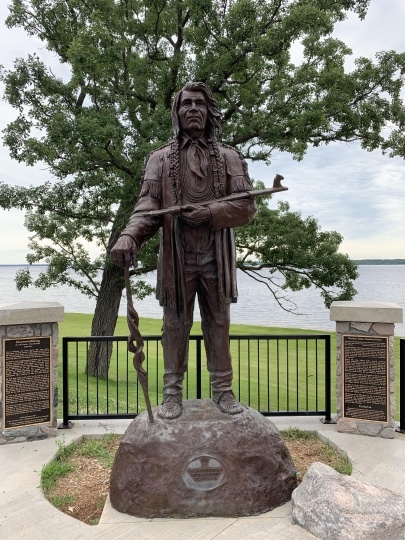
Shaynowishkung (Chief Bemidji) statue
Statue of Shaynowishkung (He Who Rattles, also called Chief Bemidji). Photograph by Peter DeCarlo, 2019. Used with the permission of Peter DeCarlo.
All rights reserved
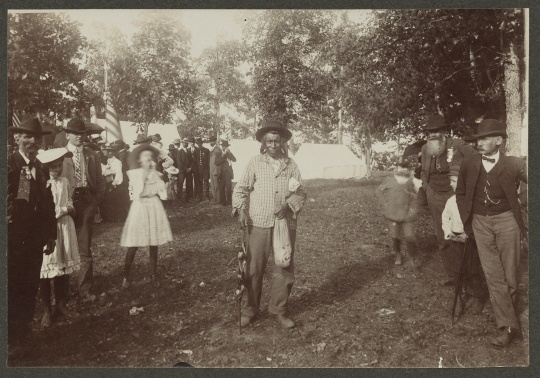
Shaynowishkung with his Diamond Willow cane
Shawynowishkung (He Who Rattles, also called Chief Bemidji) with his Diamond Willow cane, about 1900.
Holding Location
More Information
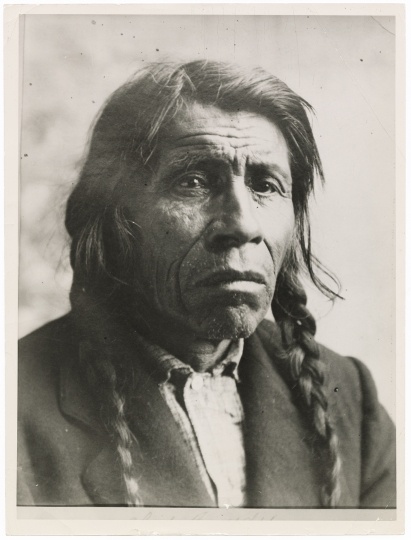
Shaynowishkung, about 1895
Shaynowishkung (He Who Rattles, also called Chief Bemidji), about 1895.
Holding Location
More Information

Shaynowishkung about 1900
Shaynowishkung (He Who Rattles, also called Chief Bemidji), about 1900.
Holding Location
More Information
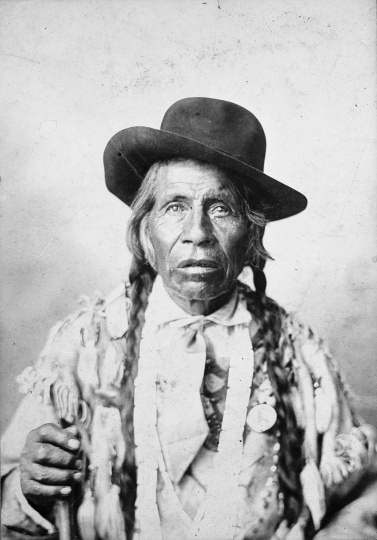
Shaynowishkung about 1900
Shaynowishkung (He Who Rattles, also called Chief Bemidji), about 1900. Photograph by Niels Larsson Hakkerup.
Holding Location
More Information
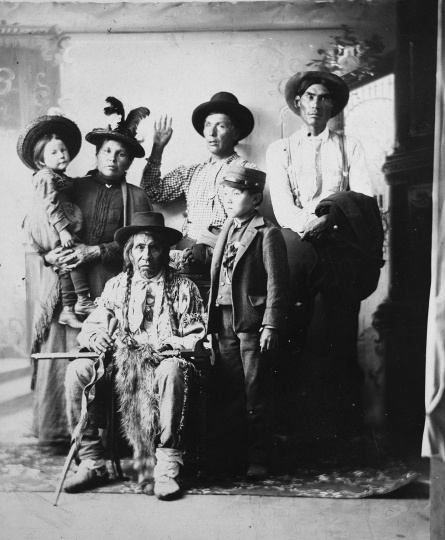
Shaynowishkung and his family
Shaynowishkung (He Who Rattles, also called Chief Bemidji), seated, with his family, about 1900. He is holding his Diamond Oak cane and opwaagan (sacred pipe).
Holding Location
More Information
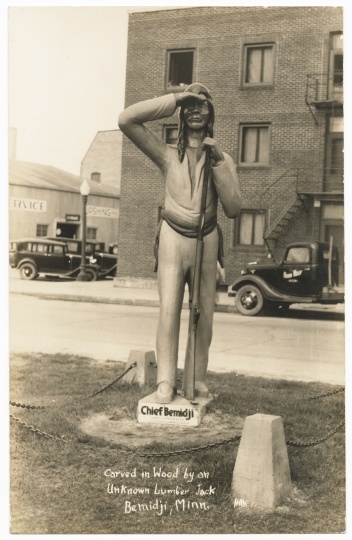
First Shaynowishkung (Chief Bemidji) statue
The first statue of Shaynowishkung (He Who Rattles, also called Chief Bemidji) in Bemidji, ca. 1930.
Holding Location
More Information
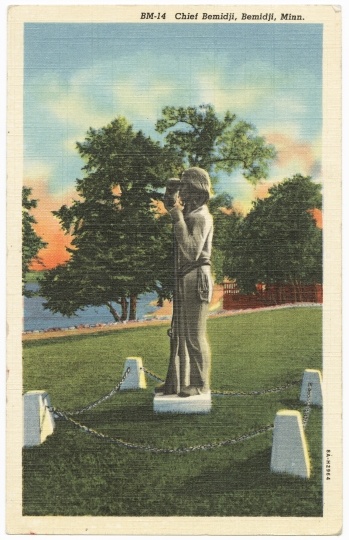
First Shaynowishkung (Chief Bemidji) statue
Color postcard with an image of the first statue of Shaynowishkung (He Who Rattles, also called Chief Bemidji) in Bemidji, ca. 1950.
Holding Location
More Information
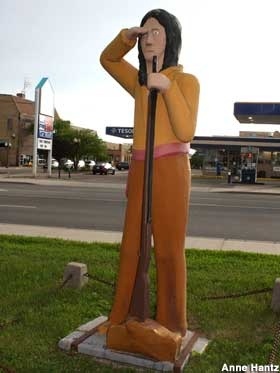
Second Shaynowishkung statue
The second Shaynowishkung (He Who Rattles, also known as Chief Bemidji) statue, erected in Bemidji in 1952. Photograph by Anne Hantz, 2014.
Holding Location
More Information
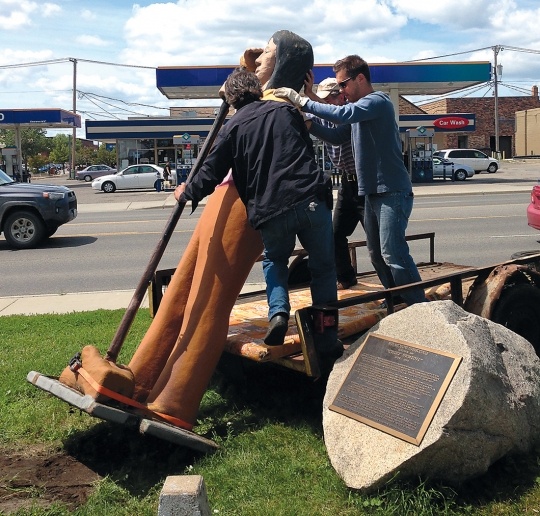
Removal of the second (1952) Shaynowishkung statue
Removal of the second statue of Shaynowishkung (He Who Rattles, also known as Chief Bemidji), originally installed in Bemidji in 1952. Photograph by the Bemidji Pioneer, 2014. Used with the permission of the Bemidji Pioneer.
Holding Location

Ojibwe spiritual Leader Larry Aitken with Shaynowishkung statue
Leech Lake Ojibwe spiritual leader Larry Aitken speaking at the dedication ceremony for the third statue of Shaynowishkung (He Who Rattles, also known as Chief Bemidji), July 6, 2015. Photograph by Michael Meuers for The Circle, July 2015. Used with the permission of The Circle.
Holding Location
More Information
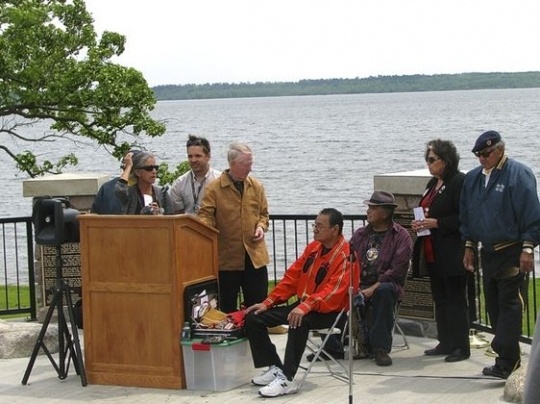
Committee members and Ojibwe leaders at statue dedication
Committee members and Ojibwe leaders at the Shaynowishkung (He Who Rattles, also known as Chief Bemidji) statue dedication ceremony, June 6, 2015. Pictured, left to right, are Carolyn Jacobs, Mitch Blessing, Jon Romer, Larry Aiken, Windy Downwind, Kathryn "Jody" Beaulieu, and Joe Day. Photograph by Red Lake Nation News.
All rights reserved
More Information
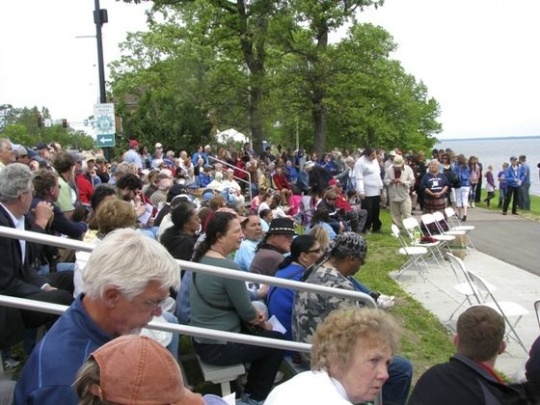
Crowd at dedication of third Shaynowishkung statue
Crowd at the dedication of the third statue of Shaynowishkung (He Who Rattles, also known as Chief Bemidji), June 6, 2015. Photograph by Red Lake Nation News. Used with the permission of Red Lake Nation News.
All rights reserved
More Information
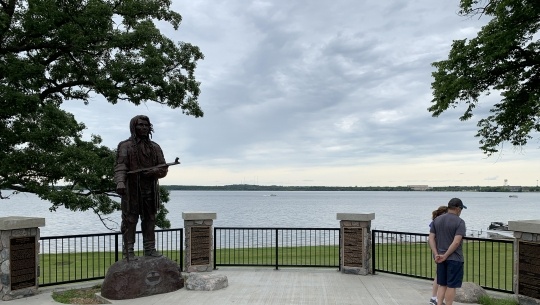
Third Shaynowishkung statue and landing area
The third statue of Shaynowishkung (He Who Rattles, also known as Chief Bemidji) and surrounding landing area. The statue was installed in Bemidji in 2015. Photograph by Peter DeCarlo, 2019. Used with the permission of Peter DeCarlo.
All rights reserved
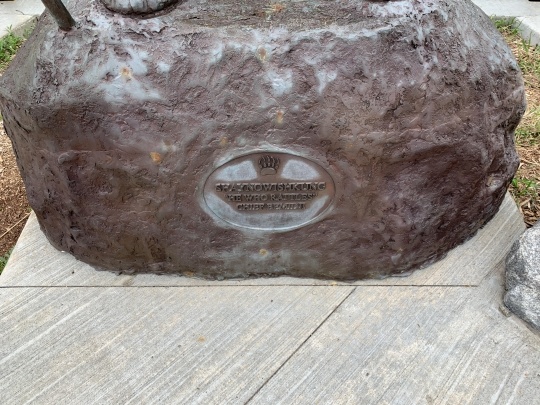
Base of third Shaynowishkung statue
Base of the third statue of Shaynowishkung (He Who Rattles, also known as Chief Bemidji), installed in Bemidji in 2015. The bear's paw print indicates Shaynowishkung's connection to the bear clan of Ojibwe. Photograph by Peter DeCarlo, 2019. Used with the permission of Peter DeCarlo.
All rights reserved
Related Articles
Turning Point
On June 6, 2015, the Shaynowishkung statue is installed and dedicated in a ceremony in Bemidji’s Library Park.
Chronology
ca. 1834
1840s and 1850s
1860
1862
1882
1888
late 1890s
1900
1901
1903
1904
1927
1952
1983
2009
2011
2015
Bibliography
“Chief Bemidji Statue Project.” N.d. [2009?].
http://rlnn.us/files/Chief_Bemidji_Statue_Project_Info_Sheet.pdf
Dey, Crystal. “Shaynowishkung Stands Tall: Hundreds Gather For ‘Chief Bemidji’ Statue Dedication (Photo Gallery).” Bemidji Pioneer, June 8, 2015.
https://www.bemidjipioneer.com/news/3761132-shaynowishkung-stands-tall-hundreds-gather-chief-bemidji-statue-dedication-photo
Enger, John. “Designed to Heal Divisions, Bemidji Statue Uncovers Tensions.” MPR News, June 6, 2015.
https://www.mprnews.org/story/2015/06/05/bemidji-unveils-new-statue
Meuers, Michael. “Shaynowishkung Statue Dedicated at Bemijigamaag.” Red Lake Nation News, June 15, 2015.
https://www.redlakenationnews.com/story/2015/06/15/news/shaynowishkung-statue-dedicated-at-bemijigamaag/36306.html
Shaynowishkung Statue Committee. Shaynowishkung statue plaques (in situ), Bemidji, installed 2015.
TPT. Common Ground, “Sculptor Gareth Curtiss’ Chief Bemidji Statue,” Season 7, Episode 11, February 18, 2016.
https://video.pbswisconsin.org/video/common-ground-711-sculptor-garreth-curtiss-chief-bemidji-statue
TPT. Common Ground, “Shaynowishkung,” Season 8, Episode 4, November 17, 2016.
https://www.tpt.org/common-ground/video/common-ground-804-shaynowishkung
Wesley, Bethany. “Project to Replace Chief Bemidji Statue Expands into Research.” Red Lake Nation News, October 24, 2011.
https://www.redlakenationnews.com/story/2011/10/24/news/project-to-replace-chief-bemidji-statue-expands-into-research/102320111836714572286.html
Related Resources
Secondary
Rausch, Ela, Greg Owen, and Nicole MartinRogers. Bemidji Area Study on Race Relations: An exploration of current race relations between American Indian and White Residents. St. Paul, MN: Wilder Research, February, 2009.
https://www.wilder.org/sites/default/files/imports/BemidjiAreaRacism_2-09.pdf
Warren, William W. History of the Ojibwe People. St. Paul: Minnesota Historical Society Press, 1984.
Witgen, Michael. An Infinity of Nations: How the Native New World Shaped Early North America. Philadelphia, PA: University of Pennsylvania Press, 2012.
Web
Beltrami History Center.
https://beltramihistory.org
“Chief Bemidji Statue.” Roadside America.
https://www.roadsideamerica.com/story/24048
















